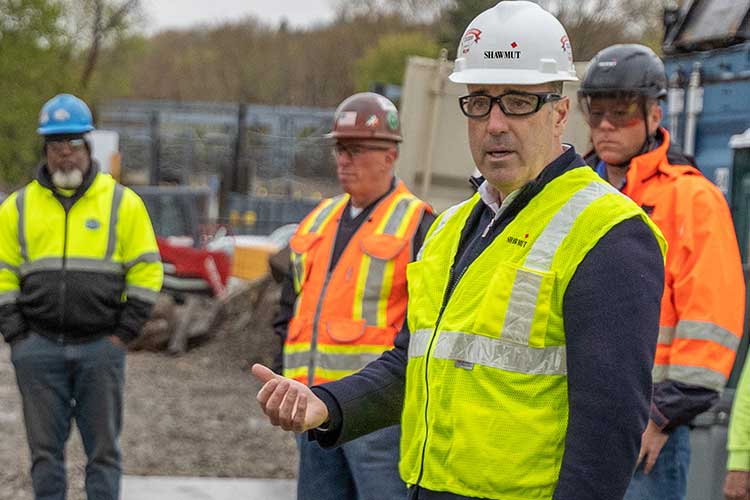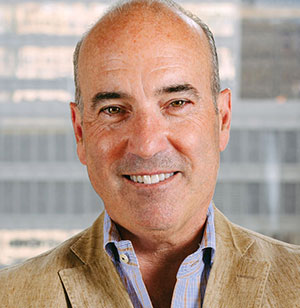The 2023 CEOs Who “Get It”

Les Hiscoe
CEO
Shawmut Design and Construction
New York, NY

Shawmut Design and Construction is a $1.3 billion national construction management firm with a reputation for completing extraordinarily complex and logistically challenging projects. As a 100% employee-owned company, Shawmut has created a culture of safety, ownership, proactive solution-making and forward-thinking. The firm completes hundreds of projects annually with its 1,000-person workforce, tens of thousands of onsite workers and up to 8,000 unique subcontractor companies.
Describe your personal journey to becoming a CEO who “gets it.” What experiences or lessons brought you to where you are now?

I’ve worked in the construction industry for over 30 years – 24 of which have been at Shawmut. From studying engineering at the University of New Hampshire to starting my construction career in the field as a superintendent to becoming CEO, safety has always been my top priority. Having worked long hours on jobsites for many years, I’ve experienced firsthand the high-stakes, fast-paced construction environment. Everyone is working as quickly as possible to deliver projects on time and on budget, multitasking, and dealing with hundreds of people in a day – so, it’s not surprising that people could lose sight of safety. But in these environments, everything can instantly change to cause risks and incidents. Technology, protocols and standards have certainly evolved over the past 30 years, but I’ve carried the same essential lessons about safety throughout my career, including:
- Safety should always be the No. 1 priority. Don’t cut corners, make impulsive decisions or shirk protocols. It is always better to do things the right way, safely.
- Safety extends beyond the bounds of your team. It encompasses far more than employees – it reaches into the local community, general public and families of all involved.
- It’s not just about sending everyone home safely, but also sending everyone home more informed, so they come back even better the next day.
- Safety is not something you focus on just at the beginning of the year to check the box. Strive for continuous improvement and innovation by implementing new technologies, trainings and resources. It’s all day, every day.
What is the biggest obstacle to safety at your organization. How do you work to overcome it?
While incredibly rewarding, construction is one of the most taxing professions. Our frontline teams complete complex, physical work daily and can work long hours in intense, demanding environments. This work can take a physical and mental toll on workers – nearly 60% of construction workers recently reported struggling with mental health, and the industry experiences the second highest rate of suicide among major industries. Although this is an industrywide problem that won’t be solved overnight, we have resources dedicated to actively fostering a safe and injury-free environment that prioritizes the safety of the whole person, physically and psychologically. This is our No. 1 priority because there is nothing more important to me than not only sending everyone home safely every night but ensuring they feel safe and secure on the job.
We work tirelessly to drive engagement and buy-in of our safety and total worker health mindset not only with our 1,000-person workforce, but our entire subcontractor network. We implemented Culture of Care toolbox talks with the specific goal of making our jobsites more inclusive. They are shared monthly companywide, focused on topics ranging from empathy and mental health to racism and veteran awareness, and our teams gather all members of the field together to review each topic, demonstrating to all the importance of this work and our commitment to it.
Why is safety a core value at your organization?
The construction industry is consistently named one of the most dangerous. Therefore, the most critical component is safety, without question. Nothing else matters if each person doesn’t go home safely each night. Since Shawmut’s inception 40 years ago, safety has been a core value. Safety is embedded into Shawmut’s culture as a top-down and bottom-up business imperative. This drives a sense of ownership, with buy-in and engagement from every employee. It also drives results – seeing a decrease in incidents fuels an increase in employees working to uncover even more safety systems and technologies to push us closer to our goal of zero incidents. Everything we do is dedicated to every employee’s holistic health, safety and well-being.
How do you instill a sense of safety in employees on an ongoing basis?
Safety is at the forefront of everything our teams do – and what we call the Shawmut Way. We’ve created a culture of safety where everyone who walks onto a site or into an office knows that safety is our No. 1 priority. Our teams lead by example and hold our subcontractors and partners to the same high standard we’ve set. We pilot and implement new technologies to keep our safety program on the cutting edge, start every meeting with a safety moment, and constantly look for ways to push our program toward predictive safety. We were one of the first firms to celebrate the annual Safety Week, where we host a weeklong blitz of safety trainings and interactive events for our people, subcontractors and partners in a united effort to raise awareness and engagement.
When it comes to adopting new technologies, our philosophy is to maximize efficiency and automation through a buy-it-and-try-it mentality. Instead of rolling out technology stacks enterprisewide, we pilot and test multiple options on a smaller scale, eliminating the penalty of failure – which is the key to engagement and innovation. This allows us to cultivate safety champions who vet, pilot, and deploy new innovations and who aren’t afraid to fail fast and try and retry. This approach allows us to make informed decisions on larger-scale integration.
All of this creates a culture of safety and continuous improvement that drives a proactive, preventive safety program.
How does your organization measure safety? What are the leading indicators that show you how safe your organization is, and where do you see room for improvement?
Our goal will always be zero incidents, and there will always be room for improvement. Safety is our business imperative, and we pride ourselves on our world-class safety program that goes above and beyond what is mandated. Our corporate safety steering committee, shored up by our regional safety branches, ensures everyone adheres to our practices and expectations. Regional safety managers are our boots-on-the-ground safety champions who drive local initiatives, and large, complex projects have dedicated safety managers overseeing all operations. We also have a customized safety scoring platform that identifies project safety risks by pulling jobsite data from our different technologies and platforms. We track all the common items from a leading and lagging perspective, such as safety inspections, observations, quality of reporting, high-hazard issues and incidents. These all roll up into a safety score for each individual contributor as well as for the project, so we have real-time information on total safety engagement. Additionally, our safety team routinely audits our sites for additional leading indicators. Finally, our senior and executive leadership teams conduct quarterly safety blitzes to drive more top-down safety engagement. This allows us to address areas that need more resources and support before an incident occurs.
What role does off-the-job safety play in your organization’s overall safety program?
Off-the-job safety is just as crucial as on-the-job safety. Safety doesn’t just stop when you are off the construction site. We know that our teams do their best work safely when caring for themselves outside of work. We offer benefits and resources to help our employees be their best selves. Our employee assistance program offers confidential, 24/7 help, including counseling and information, as well as resources on emotional, financial, legal, family and work-life issues. Throughout the year, we host webinars covering topics from resiliency to managing worry and anxiety. Perhaps the most critical example of off-the-job safety is that the construction industry is currently facing an opioid crisis. To proactively combat this and provide resources for not only Shawmut but our entire network, we created a cross-functional opioid task force; supply all Shawmut jobsites with Narcan; and provide all field staff with substance use disorder training, including the administration of Narcan.
What have you done to support employee mental health and well-being within your organization?
We promote a culture of care where we look out for and support each other, work to break stigmas around mental health, and keep well-being at the forefront of everything we do to support our people and those they care about. Our leaders are taught to address the stigma head-on, lead by example, and model self-care and work-life balance. Our executive leadership team recently had an offsite with a mental health professional to help us with the challenges we face caring for our own mental health – and that of the 1,000 people at Shawmut who rely on us – with an emphasis on how to avoid or manage burnout. While the work is never done, we’ve laid the groundwork for a workplace where everyone is seen, heard and valued, allowing people to safely open up about their struggles – without blame, stigma or judgment. We recently introduced mindfulness training, and our enhanced toolbox talks address Total Worker Health and safety every month. We have an intentional benefits program designed to support mental health, with everything put in place to nurture and advance the wellness of our people. This starts with our robust health care package, employee assistance program, ample vacation and holidays, Shawmut Flex, and Summer Fridays. Research shows that improving worker safety from a mental health and well-being perspective can significantly reduce safety incidents. That is why our safety program encompasses both mental and physical health.
Post a comment to this article
Safety+Health welcomes comments that promote respectful dialogue. Please stay on topic. Comments that contain personal attacks, profanity or abusive language – or those aggressively promoting products or services – will be removed. We reserve the right to determine which comments violate our comment policy. (Anonymous comments are welcome; merely skip the “name” field in the comment box. An email address is required but will not be included with your comment.)


